
# 4845 - 2013 First-Class Forever Stamp - Kwanzaa
U.S. # 4845
2013 46¢ Kwanzaa
Holiday Celebrations
On December 26, 1966, Maulana Karenga celebrated the first Kwanzaa.
In 1965, a deadly riot rocked a largely African-American neighborhood in Los Angeles, leaving 34 dead and 1,000 injured. Professor of Black Studies and former activist Maulana Karenga was disturbed by the violence. He wanted to help the African American community overcome the despair this riot, and ones like it, had caused. Karenga was then inspired by the African harvest celebrations to establish his own non-religious holiday that would stress the importance of family and community.

So, on December 26, 1966, Karenga led his community in celebrating the first Kwanzaa. The name is taken from a phrase meaning “first fruits” in Swahili, an East African language.
With its fusion of ancient African practices and African-American ideals and aspirations, Kwanzaa is a non-denominational celebration. It is seen as a time for the gathering of families, and for rededication to the seven principles of Nguzo Saba, a set of values as expressed by Karenga.

The Kwanzaa principles are Umoja (unity), Kujichagulia (self-determination), Ujima (collective work and responsibility), Ujamaa (cooperative economics), Nia (purpose), Kuumba (creativity), and Imani (faith). Each day of Kwanzaa is dedicated to one of these principles.
During each evening of the seven-day holiday, family members light one of the seven candles of the kinara (candleholder), and then discuss that day’s principle. The first is the black candle in the center, which symbolizes African people everywhere. Three red candles, representing the blood of ancestors, are on the left. Three green candles, symbolizing the earth, life, and promise for the future, are on the right.

There are several items common to a Kwanzaa celebration that have special significance. They are the mkeka, a straw mat symbolizing the earth; muhindi, ears of corn that symbolize offspring; zawadi, gifts symbolizing the parents’ work and the rewards of children; kinara, a seven-space candle holder, symbolizing the stalk from which the African people grew; and mishumaa saba, seven candles symbolizing the Seven Principles.
U.S. # 4845
2013 46¢ Kwanzaa
Holiday Celebrations
On December 26, 1966, Maulana Karenga celebrated the first Kwanzaa.
In 1965, a deadly riot rocked a largely African-American neighborhood in Los Angeles, leaving 34 dead and 1,000 injured. Professor of Black Studies and former activist Maulana Karenga was disturbed by the violence. He wanted to help the African American community overcome the despair this riot, and ones like it, had caused. Karenga was then inspired by the African harvest celebrations to establish his own non-religious holiday that would stress the importance of family and community.

So, on December 26, 1966, Karenga led his community in celebrating the first Kwanzaa. The name is taken from a phrase meaning “first fruits” in Swahili, an East African language.
With its fusion of ancient African practices and African-American ideals and aspirations, Kwanzaa is a non-denominational celebration. It is seen as a time for the gathering of families, and for rededication to the seven principles of Nguzo Saba, a set of values as expressed by Karenga.

The Kwanzaa principles are Umoja (unity), Kujichagulia (self-determination), Ujima (collective work and responsibility), Ujamaa (cooperative economics), Nia (purpose), Kuumba (creativity), and Imani (faith). Each day of Kwanzaa is dedicated to one of these principles.
During each evening of the seven-day holiday, family members light one of the seven candles of the kinara (candleholder), and then discuss that day’s principle. The first is the black candle in the center, which symbolizes African people everywhere. Three red candles, representing the blood of ancestors, are on the left. Three green candles, symbolizing the earth, life, and promise for the future, are on the right.

There are several items common to a Kwanzaa celebration that have special significance. They are the mkeka, a straw mat symbolizing the earth; muhindi, ears of corn that symbolize offspring; zawadi, gifts symbolizing the parents’ work and the rewards of children; kinara, a seven-space candle holder, symbolizing the stalk from which the African people grew; and mishumaa saba, seven candles symbolizing the Seven Principles.













